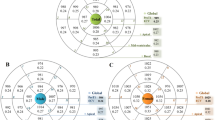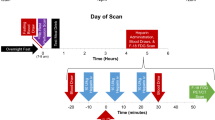Abstract
Post-contrast myocardial T1 (T1myo,c) values have been shown to be sensitive to myocardial fibrosis. Recent studies have shown differences in results obtained from T1myo,c and extracellular volume fraction (ECV) with respect to percentage fibrosis. By exploring the relationship between blood plasma volume and T1myo,c, the underlying basis for the divergence can be explained. Furthermore, dose administration based on body mass index (BMI), age and gender can mitigate the divergence in results. Inter-subject comparison of T1myo,c required adjustment for dose (in mmol/kg), time and glomerular filtration rate. Further adjustment for effective dose based on lean muscle mass reflected by blood/plasma volume was performed. A test case of 605 subjects from the MESA study who had undergone pre- and post-contrast T1 mapping was studied. T1myo,c values were compared between subjects with and without metabolic syndrome (MetS), between smoking and non-smoking subjects, and subjects with and without impaired glucose tolerance, before and after dose adjustment based on plasma volume. Comparison with ECV (which is dose independent), pre-contrast myocardial T1 and blood normalized myocardial T1 values was also performed to validate the correction. There were significant differences in T1myo,c (post plasma volume correction) and ECV between current and former smokers (p value 0.017 and 0.01, respectively) but not T1myo,c prior to correction (p = 0.12). Prior to dose adjustment for plasma volume, p value was <0.001 for T1myo,c between MetS and non-MetS groups and was 0.13 between subjects with and without glucose intolerance; after adjustment for PV, p value was 0.63 and 0.99. Corresponding ECV p values were 0.44 and 0.99, respectively. Overall, ECV results showed the best agreement with PV corrected T1myo,c (mean absolute difference in p values = 0.073) and pre-contrast myocardial T1 in comparison with other measures (T1myo,c prior to correction, blood/plasma T1 value normalized myocardium). Weight-based contrast dosing administered in mmol/kg results in a bias in T1 values which can lead to erroneous conclusions. After adjustment for lean muscle mass based on plasma volume, results from T1myo,c were in line with ECV derived results. Furthermore, the use of a modified equivalent dose adjusted for BMI, age, sex and hematocrit can be adopted for quantitative imaging.



Similar content being viewed by others
References
Iles L, Pfluger H, Phrommintikul A, Cherayath J, Aksit P, Gupta SN, Kaye DM, Taylor AJ (2008) Evaluation of diffuse myocardial fibrosis in heart failure with cardiac magnetic resonance contrast-enhanced T1 mapping. J Am Coll Cardiol 52(19):1574–1580. doi:10.1016/j.jacc.2008.06.049
Sibley CT, Noureldin RA, Gai N, Nacif MS, Liu S, Turkbey EB, Mudd JO, van der Geest RJ, Lima JA, Halushka MK, Bluemke DA (2012) T1 mapping in cardiomyopathy at cardiac MR: comparison with endomyocardial biopsy. Radiology 265(3):724–732. doi:10.1148/radiol.12112721
Sparrow P, Messroghli DR, Reid S, Ridgway JP, Bainbridge G, Sivananthan MU (2006) Myocardial T1 mapping for detection of left ventricular myocardial fibrosis in chronic aortic regurgitation: pilot study. AJR Am J Roentgenol 187(6):W630–W635. doi:10.2214/AJR.05.1264
Maceira AM, Prasad SK, Hawkins PN, Roughton M, Pennell DJ (2008) Cardiovascular magnetic resonance and prognosis in cardiac amyloidosis. J Cardiovasc Magn Reson 10:54. doi:10.1186/1532-429X-10-54
Schalla S, Bekkers SC, Dennert R, van Suylen RJ, Waltenberger J, Leiner T, Wildberger J, Crijns HJ, Heymans S (2010) Replacement and reactive myocardial fibrosis in idiopathic dilated cardiomyopathy: comparison of magnetic resonance imaging with right ventricular biopsy. Eur J Heart Fail 12(3):227–231. doi:10.1093/eurjhf/hfq004
Ellims AH, Shaw JA, Stub D, Iles LM, Hare JL, Slavin GS, Kaye DM, Taylor AJ (2014) Diffuse myocardial fibrosis evaluated by post-contrast T1 mapping correlates with left ventricular stiffness. J Am Coll Cardiol 63(11):1112–1118. doi:10.1016/j.jacc.2013.10.084
Miller CA, Naish JH, Bishop P, Coutts G, Clark D, Zhao S, Ray SG, Yonan N, Williams SG, Flett AS, Moon JC, Greiser A, Parker GJ, Schmitt M (2013) Comprehensive validation of cardiovascular magnetic resonance techniques for the assessment of myocardial extracellular volume. Circ Cardiovasc Imaging 6(3):373–383. doi:10.1161/CIRCIMAGING.112.000192
Messroghli DR, Nordmeyer S, Dietrich T, Dirsch O, Kaschina E, Savvatis K, Oh-I D, Klein C, Berger F, Kuehne T (2011) Assessment of diffuse myocardial fibrosis in rats using small-animal Look-Locker inversion recovery T1 mapping. Circ Cardiovasc Imaging 4(6):636–640. doi:10.1161/CIRCIMAGING.111.966796
Neilan TG, Coelho-Filho OR, Shah RV, Abbasi SA, Heydari B, Watanabe E, Chen Y, Mandry D, Pierre-Mongeon F, Blankstein R, Kwong RY, Jerosch-Herold M (2013) Myocardial extracellular volume fraction from T1 measurements in healthy volunteers and mice: relationship to aging and cardiac dimensions. JACC Cardiovasc Imaging 6(6):672–683. doi:10.1016/j.jcmg.2012.09.020
Koopmann M, Hong K, Kholmovski EG, Huang EC, Hu N, Ying J, Levenson R, Vijayakumar S, Dosdall DJ, Ranjan R, Kim D (2014) Post-contrast myocardial T and ECV disagree in a longitudinal canine study. NMR Biomed. doi:10.1002/nbm.3135
Gai ND, Stehning C, Nacif M, Bluemke DA (2013) Modified Look-Locker T1 evaluation using Bloch simulations: human and phantom validation. Magn Reson Med 69(2):329–336. doi:10.1002/mrm.24251
Kellman P, Herzka DA, Arai AE, Hansen MS (2013) Influence of Off-resonance in myocardial T1-mapping using SSFP based MOLLI method. J Cardiovasc Magn Reson 15:63. doi:10.1186/1532-429X-15-63
Kellman P, Hansen MS (2014) T1-mapping in the heart: accuracy and precision. J Cardiovasc Magn Reson 16:2. doi:10.1186/1532-429X-16-2
Gai N, Turkbey EB, Nazarian S, van der Geest RJ, Liu CY, Lima JA, Bluemke DA (2011) T1 mapping of the gadolinium-enhanced myocardium: adjustment for factors affecting interpatient comparison. Magn Reson Med 65(5):1407–1415. doi:10.1002/mrm.22716
Sharma P, Socolow J, Patel S, Pettigrew RI, Oshinski JN (2006) Effect of Gd-DTPA-BMA on blood and myocardial T1 at 1.5 T and 3 T in humans. J Magn Reson Imaging 23(3):323–330. doi:10.1002/jmri.20504
Donahue KM, Burstein D, Manning WJ, Gray ML (1994) Studies of Gd-DTPA relaxivity and proton exchange rates in tissue. Magn Reson Med 32(1):66–76
Feldschuh J, Enson Y (1977) Prediction of the normal blood volume. Relation of blood volume to body habitus. Circulation 56(4 Pt 1):605–612
Margouleff D (2013) Blood volume determination, a nuclear medicine test in evolution. Clin Nucl Med 38(7):534–537. doi:10.1097/RLU.0b013e318292f370
Nadler SB, Hidalgo JH, Bloch T (1962) Prediction of blood volume in normal human adults. Surgery 51(2):224–232
Manzone TA, Dam HQ, Soltis D, Sagar VV (2007) Blood volume analysis: a new technique and new clinical interest reinvigorate a classic study. J Nucl Med Technol 35(2):55–63. doi:10.2967/jnmt.106.035972 (quiz 77, 79)
Lemmens HJ, Bernstein DP, Brodsky JB (2006) Estimating blood volume in obese and morbidly obese patients. Obes Surg 16(6):773–776. doi:10.1381/096089206777346673
Messroghli DR, Radjenovic A, Kozerke S, Higgins DM, Sivananthan MU, Ridgway JP (2004) Modified Look-Locker inversion recovery (MOLLI) for high-resolution T-1 mapping of the heart. Magn Reson Med 52(1):141–146. doi:10.1002/Mm.20110
Nacif MS, Turkbey EB, Gai N, Nazarian S, van der Geest RJ, Noureldin RA, Sibley CT, Ugander M, Liu S, Arai AE, Lima JA, Bluemke DA (2011) Myocardial T1 mapping with MRI: comparison of Look-Locker and MOLLI sequences. J Magn Reson Imaging 34(6):1367–1373. doi:10.1002/jmri.22753
Piechnik SK, Ferreira VM, Lewandowski AJ, Ntusi NA, Banerjee R, Holloway C, Hofman MB, Sado DM, Maestrini V, White SK, Lazdam M, Karamitsos T, Moon JC, Neubauer S, Leeson P, Robson MD (2013) Normal variation of magnetic resonance T1 relaxation times in the human population at 1.5 T using ShMOLLI. J Cardiovasc Magn Reson 15:13. doi:10.1186/1532-429X-15-13
Lopez B, Querejeta R, Varo N, Gonzalez A, Larman M, Martinez Ubago JL, Diez J (2001) Usefulness of serum carboxy-terminal propeptide of procollagen type I in assessment of the cardioreparative ability of antihypertensive treatment in hypertensive patients. Circulation 104(3):286–291
Piechnik SK, Ferreira VM, Dall’Armellina E, Cochlin LE, Greiser A, Neubauer S, Robson MD (2010) Shortened Modified Look-Locker Inversion recovery (ShMOLLI) for clinical myocardial T1-mapping at 1.5 and 3 T within a 9 heartbeat breathhold. J Cardiovasc Magn Reson 12:69. doi:10.1186/1532-429X-12-69
Song T, Stainsby JA, Ho VB, Hood MN, Slavin GS (2012) Flexible cardiac T1 mapping using a modified Look-Locker acquisition with saturation recovery. Magn Reson Med 67(3):622–627. doi:10.1002/mrm.24137
Chow K, Flewitt JA, Green JD, Pagano JJ, Friedrich MG, Thompson RB (2014) Saturation recovery single-shot acquisition (SASHA) for myocardial T(1) mapping. Magn Reson Med 71(6):2082–2095. doi:10.1002/mrm.24878
Stanisz GJ, Henkelman RM (2000) Gd-DTPA relaxivity depends on macromolecular content. Magn Reson Med 44(5):665–667. doi:10.1002/1522-2594(200011)44:5<665:AID-MRM1>3.0.CO;2-M
Davy KP, Seals DR (1994) Total blood volume in healthy young and older men. J Appl Physiol 76(5):2059–2062
Jones PP, Davy KP, DeSouza CA, van Pelt RE, Seals DR (1997) Absence of age-related decline in total blood volume in physically active females. Am J Physiol 272(6 Pt 2):H2534–H2540
Acknowledgments
This work was supported by the NIH Clinical Center intramural research program.
Author information
Authors and Affiliations
Corresponding author
Ethics declarations
Conflict of interest
None.
Human and animal rights
All human studies in this work were approved by the individual institutional review boards and were therefore performed in accordance with the ethical standards laid down in the 1964 Declaration of Helsinki and its later amendments. All subjects gave informed consent prior to their inclusion in the study.
Rights and permissions
About this article
Cite this article
Gai, N.D., Sandfort, V., Liu, S. et al. Dose correction for post-contrast T1 mapping of the heart: the MESA study. Int J Cardiovasc Imaging 32, 271–279 (2016). https://doi.org/10.1007/s10554-015-0754-3
Received:
Accepted:
Published:
Issue Date:
DOI: https://doi.org/10.1007/s10554-015-0754-3




